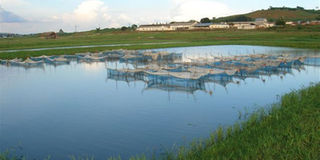Group efforts boost Namayingo fish farmers

Left is a fish pond. Fish farming is one of the many activities farmers can carry out on communal basis. Working as a team helps farmers overcome challenges that they would have had a hard time handling as individuals. File Photo.
What you need to know:
To break the obstacle to their success, farmers in Namayingo District formed a group in which they have communal responsibility to oversee the journey of their produce from planting to harvesting, and they are benefitting from their efforts.
Small holder farming requires a lot of commitment yet its productivity is typically low. Some farmers in Namayingo District, however, have found a way around it. They are making millions of shillings using an old trick – communalism.
Sibawo syahaya ohuba, which can be loosely translated to mean “something prevents me from becoming what I want,” is a group comprising 24 peasant families which in 2006 came together to boost their food security and farm incomes. Six years later, they jointly owned 16 acres of land on which they practice mixed farming – including aquaculture.
Benefits of team work
“I started a circle in 2006. Then in 2009, we acquired a grinding mill from the district community development fund. That is when I believed that working together would improve our incomes,” says Duncans Onyango, the group’s general secretary and a former primary school teacher in the Sigulu Island of Lake Victoria.
“Maize, millet and cassava are mainly for our food consumption,” Onyango says. He adds: “The fish, tomatoes, and pigs bring us money which helps us pay children’s school fees.”
The group was originally growing crops and rearing pigs just a few metres away from the lake. Sometimes heavy rains would flood their gardens, destroying crops. From this challenge, however, came the opportunity to start fish farming in 2009. They now have the largest fish farm in the district – and this is their largest source of income.
“We started fish farming partly to save our gardens by channelling the water back to the lake. Now we are doing fish farming on five acres of land because it is profitable,” Onyango says.
Their first fish harvest in 2010 was Shs4m. In 2011, they earned Shs20m from seven ponds.
“Out of the Shs20m, about half was profit. We are expecting about Shs20m this year,” he says.
“Our life has been dependant on the lake for fish. Now that it is scarce, it makes more sense to farm it,” he adds. The different families supply the labour. As some people are weeding crops, others are feeding the pigs or clearing the ponds. On this land, they have a group house as well as a store.
Each family member has a turn to oversee the farm. During his or her turn, each head of family chooses any member of their family to live with at the farm house.
Efforts rewarded
Following its success, the group has now received funding of Shs58m from the Lake Victoria Environment Management Project to enable it improve the productivity of their fish farm. On a recent visit to the fish farm, Mujib Kambo, a researcher from the National Fisheries Resources Research Institute (Nafirri), noted that although the group’s aquaculture was commendable, it still had to make improvements for better yields.
“For example, I would like (it) if they are integrating fish farming with other things, they don’t do it with tomatoes as is the case now- may be rice which does not require spraying. Fish is very sensitive to chemicals,” Kambo says.
“We have a new programme through which we will teach fish farmers how to do it best, including how to mix the ideal fish feed on their farms.”




